Steak au Poivre
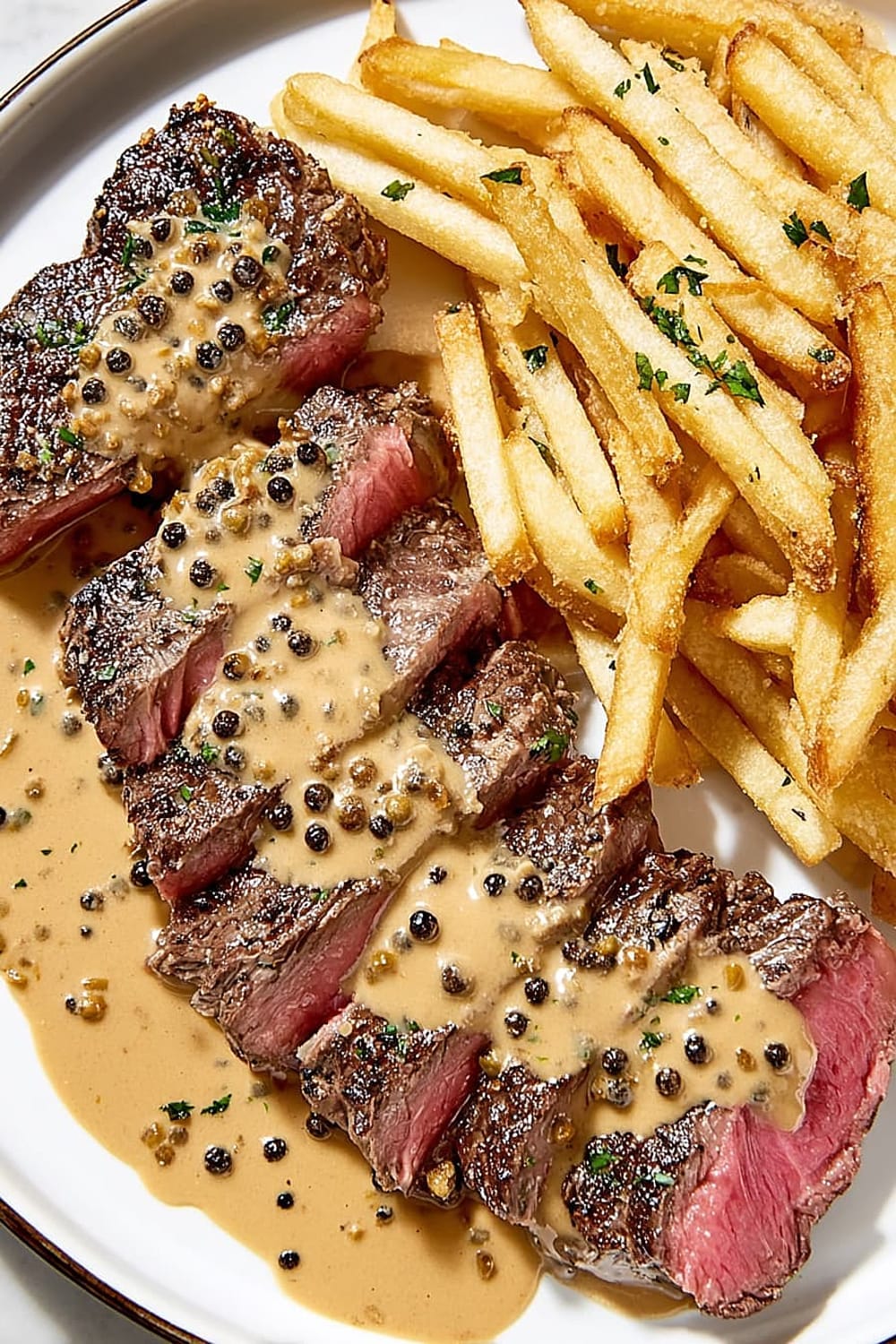
This is the kind of dish that makes you feel like you’ve stepped into a fancy French bistro, complete with the confidence boost that comes from nailing restaurant-quality food in your own kitchen.
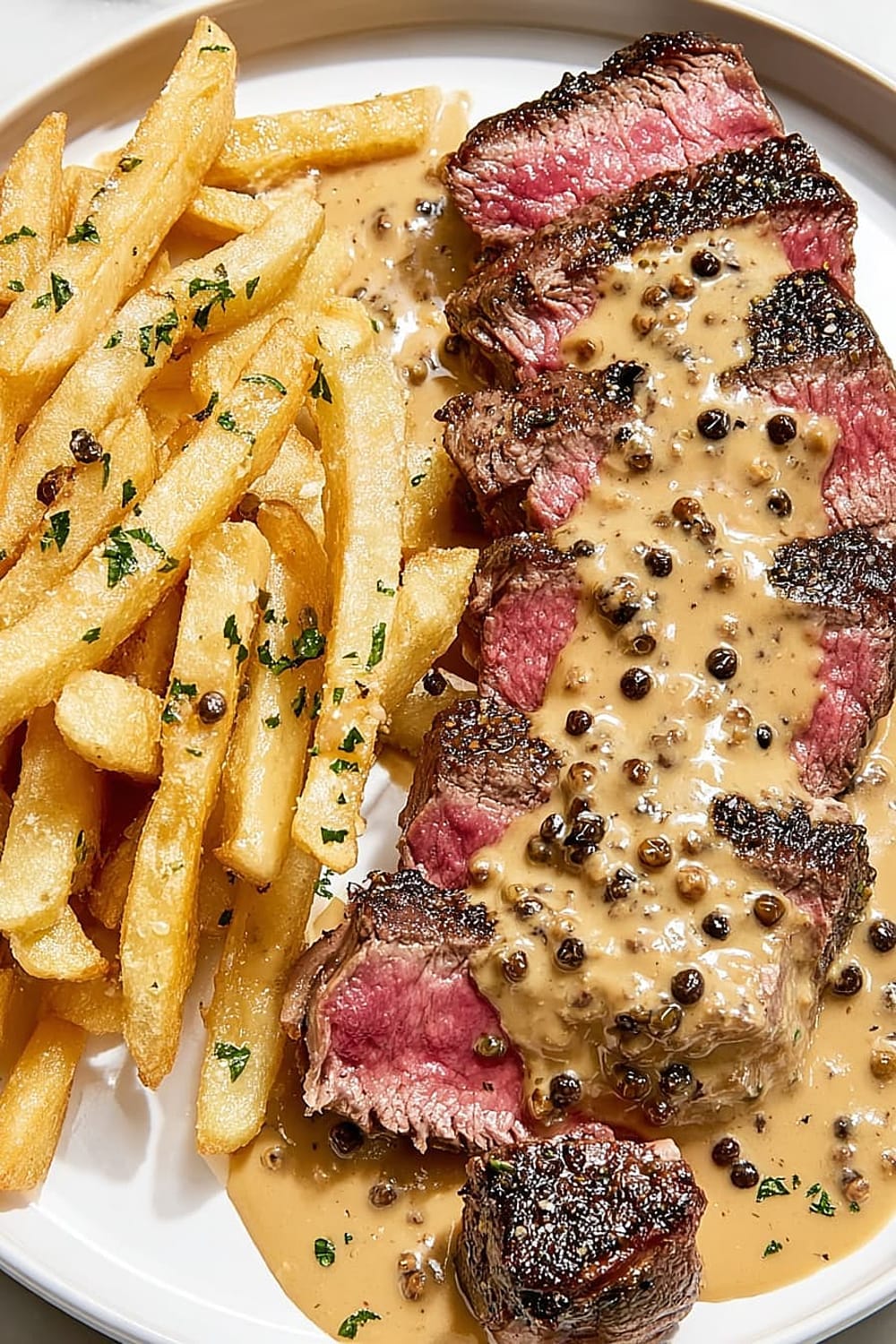
The combination of perfectly seared beef tenderloin and that rich, peppery cognac cream sauce is basically edible sophistication on a plate.
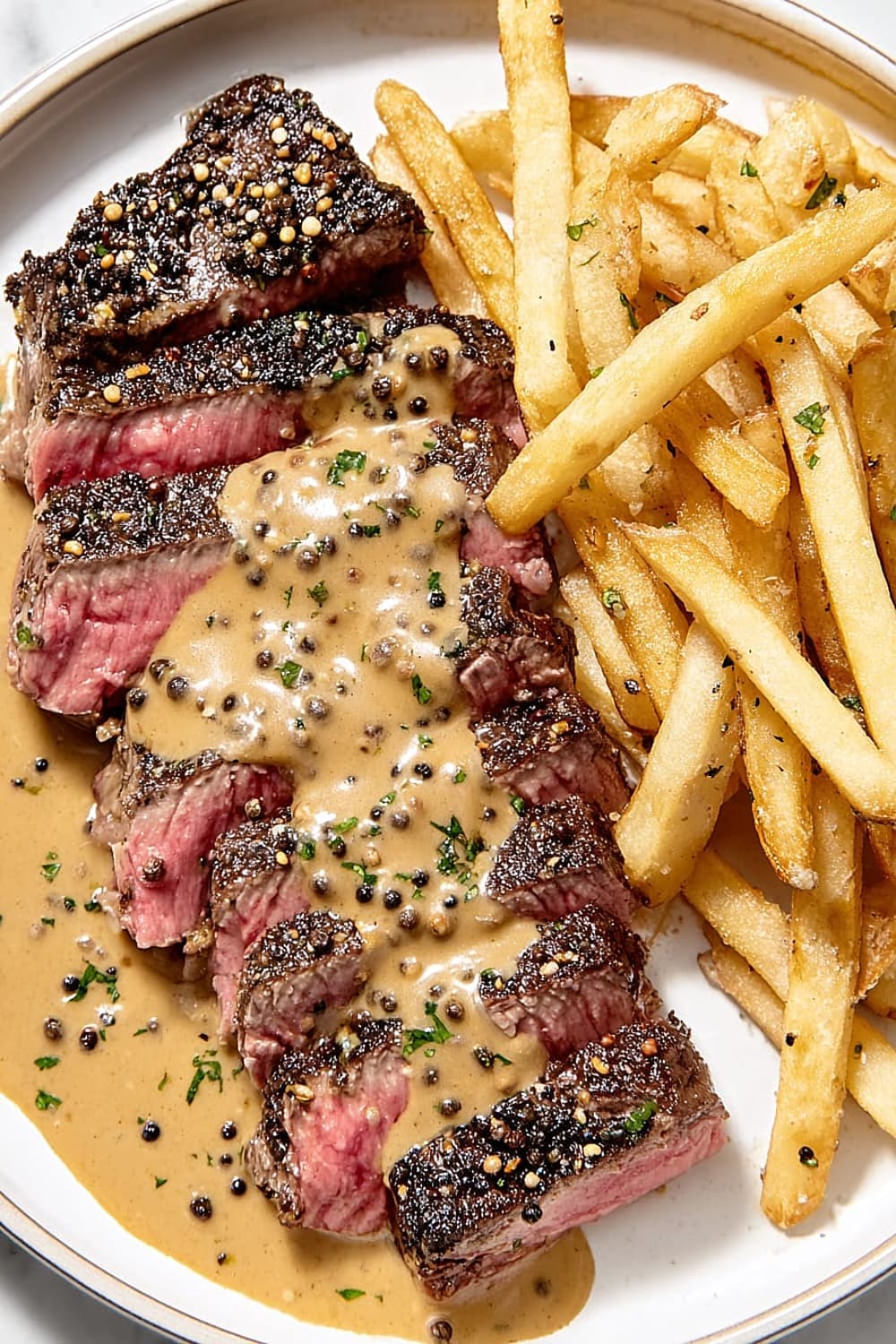
You’ll love how the coarsely crushed peppercorns create this amazing aromatic crust that gives way to tender, juicy steak underneath.
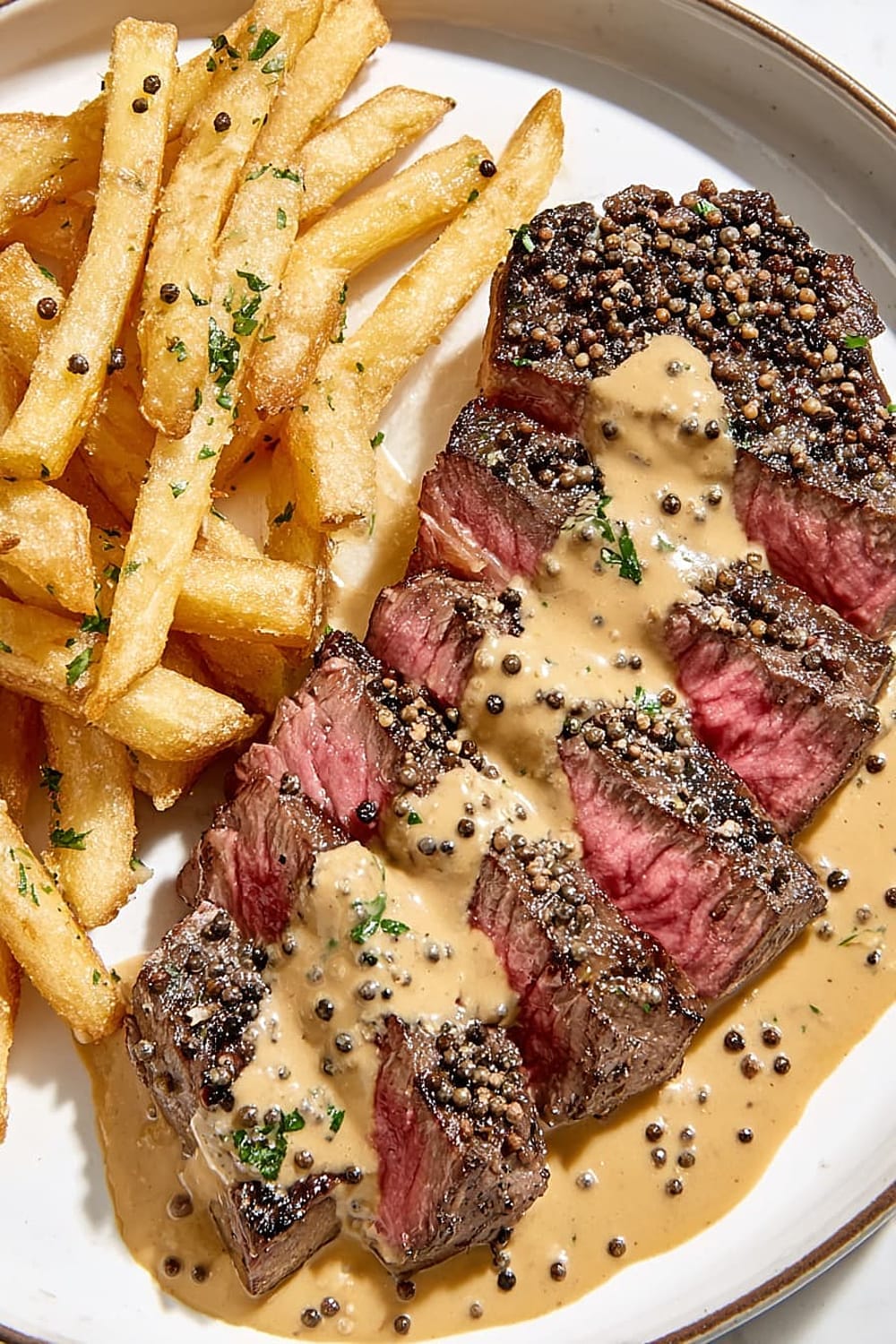
The cognac sauce isn’t just for show either – it’s silky, complex, and transforms those beautiful pan drippings into liquid gold that ties everything together.
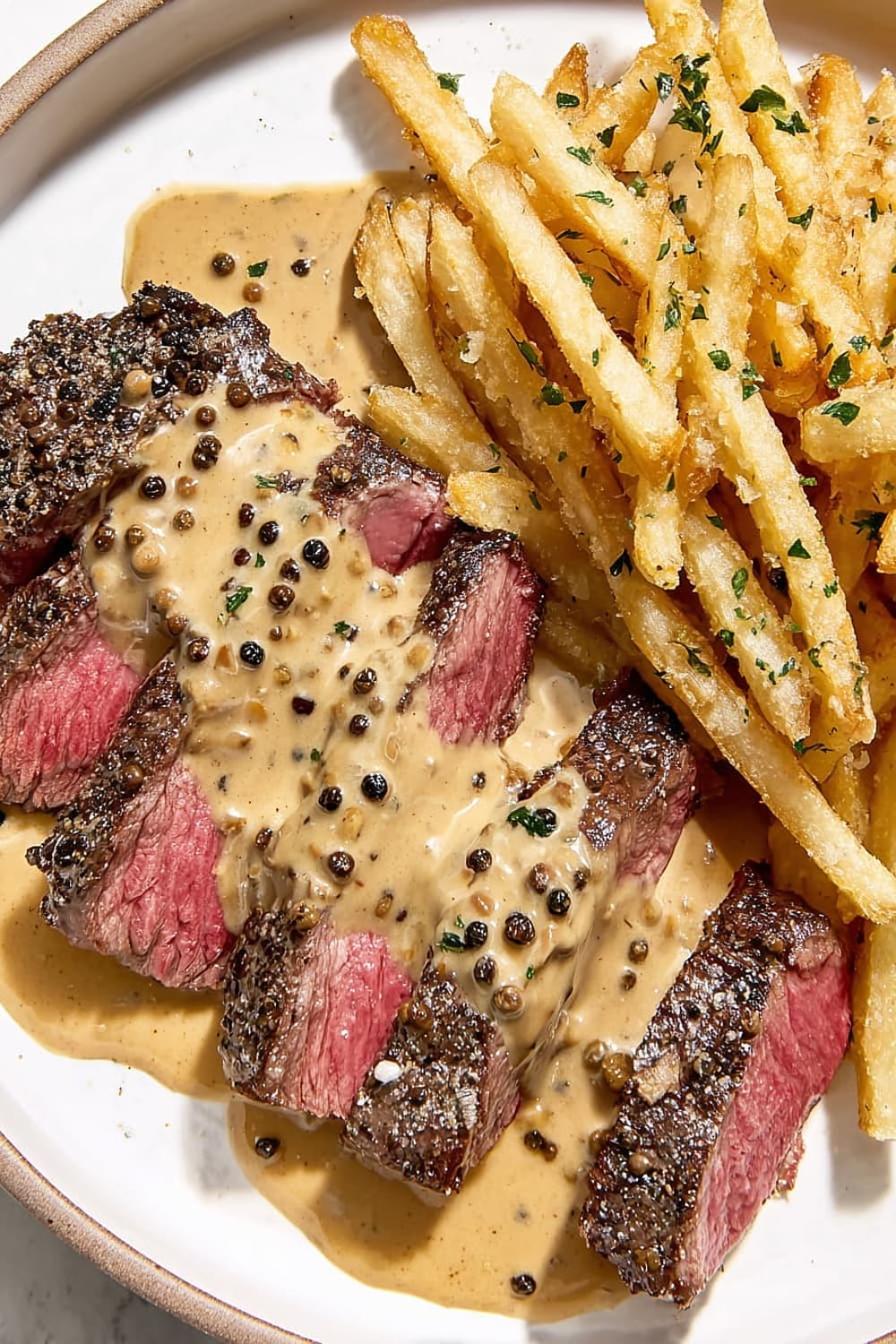
This recipe proves you don’t need culinary school to create something that’ll have your dinner guests asking if you’ve been secretly taking cooking classes.
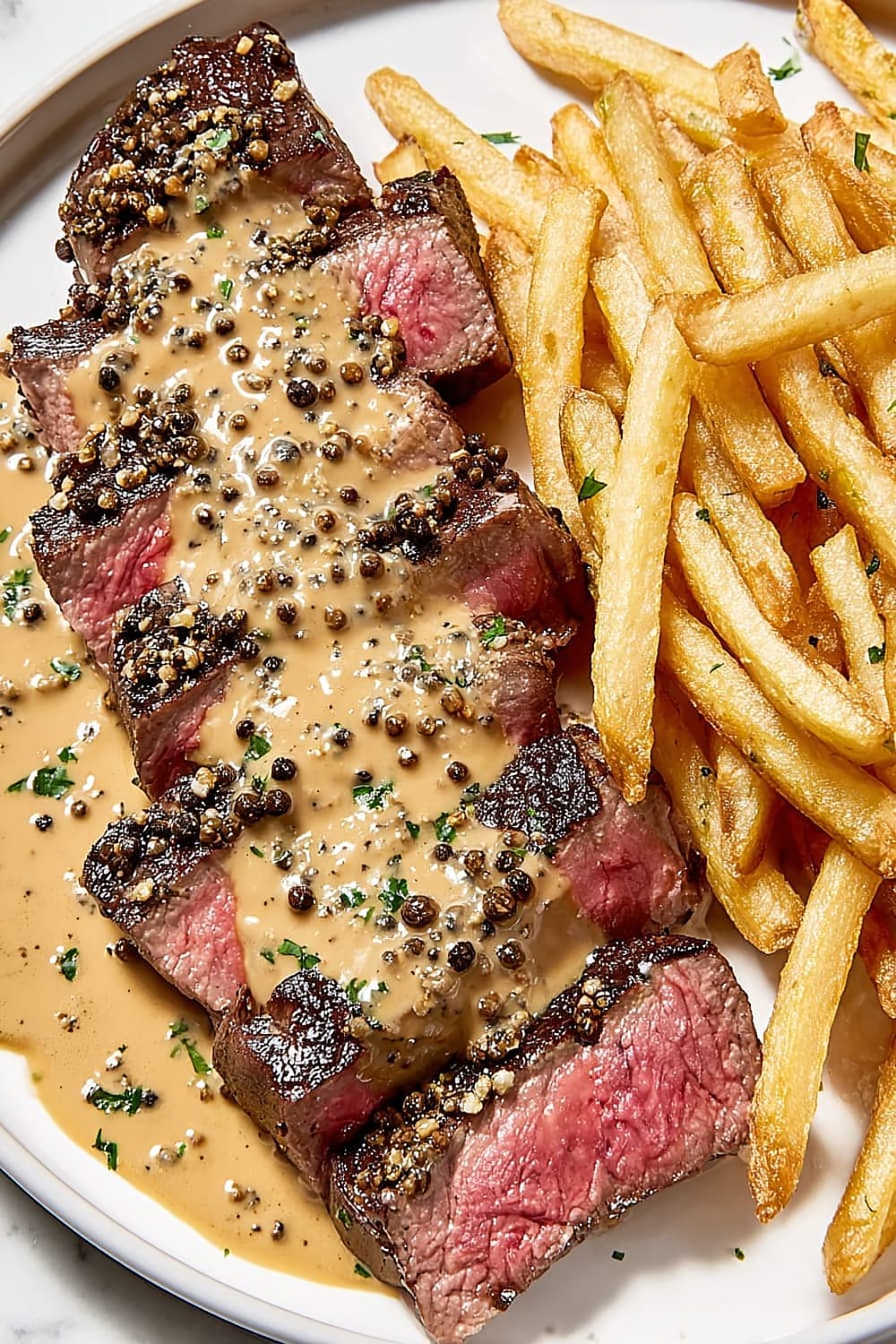
Best part is the whole thing comes together in about 35 minutes, so you can go from regular Tuesday night to “wow, what’s the occasion” without breaking a sweat.
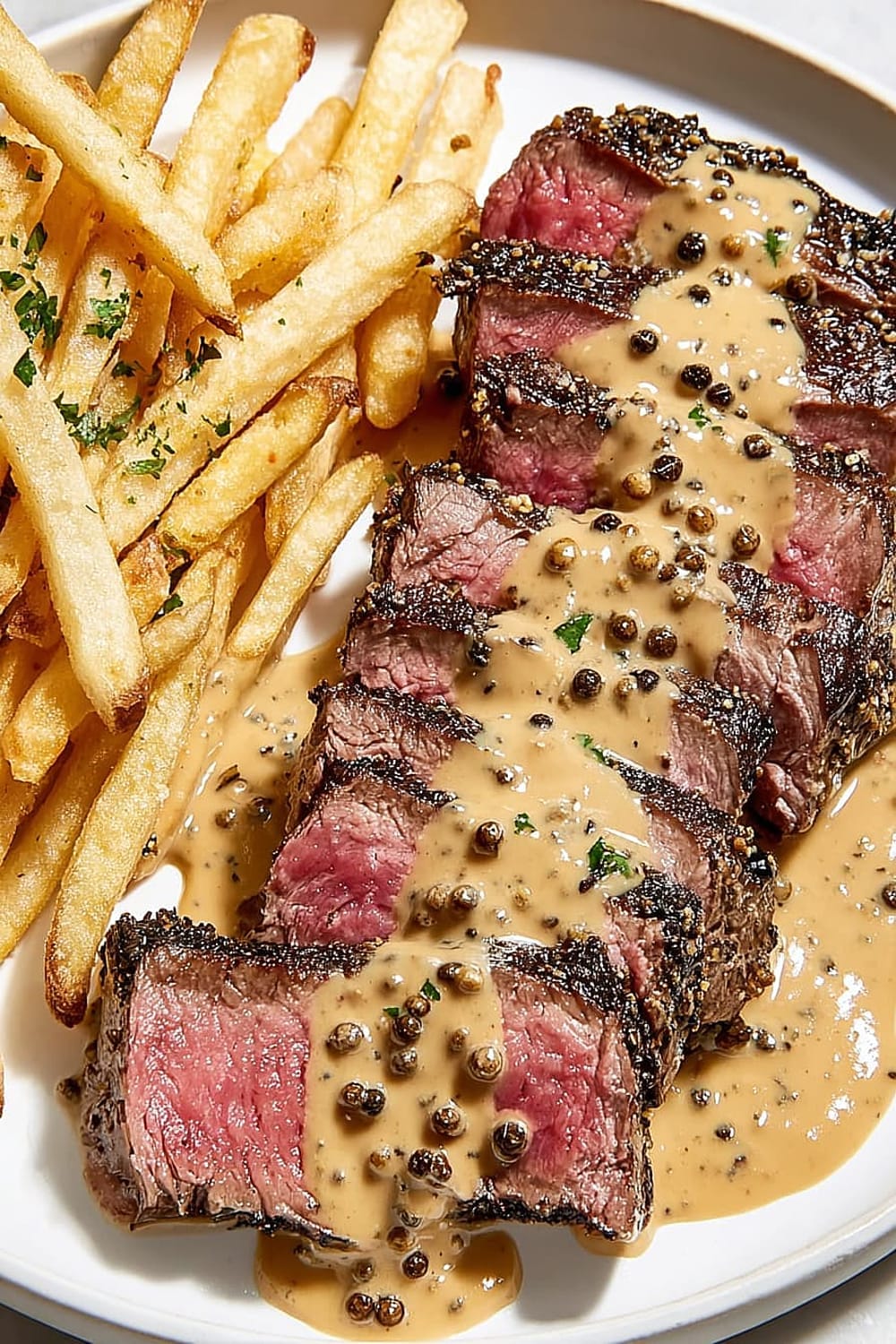
Ingredients
For the Steaks
- 4 (6-ounce) beef tenderloin steaks
- 2 tablespoons whole peppercorns, preferably a mix of black, white, pink, and red
- 1 teaspoon kosher salt
- 1 tablespoon olive oil
For the Cognac Cream Sauce
- 1 small shallot, finely minced
- 3 tablespoons unsalted butter, divided
- 1 /4 cup Cognac or brandy
- 1 /2 cup beef stock
- 1 /2 cup heavy cream
Instructions
Preparation
- 1 Remove any twine from the 4 beef tenderloin steaks and let them sit at room temperature for 30 minutes. This ensures even cooking and prevents the steaks from seizing up when they hit the hot pan. Meanwhile, finely mince 1 small shallot using a sharp knife or microplane grater for the most consistent pieces.
- 2 Coarsely crush 2 tablespoons whole peppercorns in a mortar and pestle for the best texture control, or place the peppercorns in a clean kitchen towel and crush them with a meat tenderizer or the bottom of a cast iron pan. You want irregular pieces, not powder – this creates that signature peppery bite and aromatic crust.
Seasoning the Steaks
- 3 Season the steaks all over with 1 teaspoon kosher salt, making sure to coat every surface evenly. Use your hands to press the crushed pepper firmly onto the top and bottom of each steak, creating an even coating that will form the characteristic pepper crust when seared.
Searing the Steaks
- 4 Heat a large cast iron skillet or stainless steel pan over high heat until it starts to smoke – this usually takes 3-4 minutes. The pan needs to be screaming hot to create that perfect sear. Add 1 tablespoon olive oil and 1 tablespoon of the unsalted butter, swirling to combine.
- 5 Immediately add the steaks to the hot pan and cook until medium-rare with a beautiful brown crust, 2 to 3 minutes per side. Don’t move them during cooking – let that crust develop. An instant-read thermometer inserted into the thickest part should register about 130°F (54°C) for perfect medium-rare. Transfer the steaks to a clean cutting board and cover with aluminum foil to rest.
Making the Cognac Sauce
- 6 Reduce the heat to medium and add 1 tablespoon of the remaining unsalted butter along with the minced shallot. Sauté until the shallot becomes translucent and fragrant, about 1 minute. Don’t let it brown or it’ll turn bitter.
- 7 Remove the pan from the heat completely before adding 1/4 cup Cognac – this prevents dangerous flare-ups. Return the pan to medium heat and simmer, scraping up any browned bits stuck to the bottom with a wooden spoon or silicone spatula, until the alcohol mostly evaporates, 1 to 2 minutes.
- 8 Add 1/2 cup beef stock and increase the heat to medium-high. Simmer until the liquid reduces slightly and concentrates in flavor, 2 to 3 minutes. Add 1/2 cup heavy cream and the remaining 1 tablespoon unsalted butter, stirring constantly until the sauce thickens enough to coat the back of a spoon, 2 to 3 minutes. Stir in any accumulated juices from the resting steaks for maximum flavor. Serve the steaks on individual plates with the sauce spooned generously over the top.
Recommended Equipment and Kitchen Tools
Essential Tools (for best results)
- Cast iron skillet or stainless steel pan – These materials retain and distribute heat evenly, creating the perfect sear without hot spots that can burn the pepper crust
- Instant-read thermometer – Takes the guesswork out of achieving perfect doneness, especially important with premium beef tenderloin
- Mortar and pestle – Gives you complete control over pepper texture, creating those irregular pieces that provide bursts of flavor
- Aluminum foil – Essential for properly resting the steaks while maintaining temperature
Helpful Upgrades
- Kitchen scale – For precise measurements of peppercorns and consistent results every time you make this recipe
- Silicone spatula or wooden spoon – Perfect for scraping up those flavorful fond bits without scratching your pan surface
- Quality tongs – Makes flipping steaks safer and more controlled than using a fork, which can pierce the meat
Nice-to-Have Options
- Microplane grater – Creates perfectly minced shallots with minimal effort and consistent size
- Digital timer – Helps track multiple cooking stages simultaneously, from resting time to sauce reduction
Recipe Variations and Dietary Modifications
Protein Alternatives
- Filet mignon or ribeye steaks → Use same cooking method but adjust timing based on thickness
- Pork tenderloin medallions → Reduce cooking time to 1-2 minutes per side and cook to 145°F (63°C)
- Chicken breast → Pound to 1-inch thickness and cook 4-5 minutes per side until 165°F (74°C)
Dairy-Free Modifications
- Heavy cream → Full-fat coconut cream or cashew cream for similar richness
- Unsalted butter → High-quality olive oil or vegan butter substitute
- Expect slightly different flavor profile but still deliciously creamy sauce
Lower-Fat Version
- Heavy cream → Half-and-half mixed with 1 tablespoon cornstarch for thickening
- Reduce butter to 1 tablespoon total and use cooking spray for the pan
- Add extra beef stock to maintain sauce volume
Alcohol-Free Adaptation
- Cognac → Additional 1/4 cup beef stock plus 1 teaspoon vanilla extract for complexity
- White grape juice with 1 tablespoon white wine vinegar mimics the acidity and sweetness
Flavor Variations
- Green peppercorn sauce → Use 2 tablespoons brined green peppercorns instead of crushed mixed peppercorns
- Mushroom addition → Sauté 8 ounces sliced mushrooms with the shallots for earthy depth
- Herb enhancement → Finish with fresh thyme or tarragon for aromatic complexity
Nutritional Information and Health Benefits
Key Nutritional Highlights
Each serving provides approximately 580-620 calories, with the majority coming from high-quality protein and healthy fats. The 6-ounce beef tenderloin delivers about 54 grams of complete protein, containing all essential amino acids your body needs for muscle maintenance and repair. The cream sauce adds richness but also contributes calcium and vitamin A, while keeping carbohydrates minimal at around 4-5 grams per serving.
Health Benefits of Main Ingredients
Beef tenderloin is an excellent source of iron, zinc, and B-vitamins, particularly B12 which supports nerve function and red blood cell formation. The mixed peppercorns aren’t just for flavor – they contain piperine, a compound that may enhance nutrient absorption and has anti-inflammatory properties. Shallots provide quercetin, a powerful antioxidant that supports heart health, while cognac used in cooking retains minimal alcohol but adds complex flavors without significant calories.
Dietary Considerations
This recipe is naturally gluten-free and keto-friendly, fitting well into low-carb eating patterns. The high protein and fat content promotes satiety, making it satisfying without heavy starches. Those watching sodium should note the kosher salt and beef stock contribute most of the sodium content. The dish contains dairy and alcohol, though most alcohol cooks off during the reduction process.
Smart Swaps and Ingredient Substitutions
Common Substitutions:
- Beef tenderloin → New York strip or sirloin steaks (adjust cooking time for thickness)
- Cognac → Brandy, whiskey, or dry sherry in equal amounts
- Heavy cream → Crème fraîche or sour cream stirred in off heat to prevent curdling
- Mixed peppercorns → All black peppercorns work perfectly if specialty varieties aren’t available
Budget-Friendly Swaps:
- Beef tenderloin → Top sirloin or flat iron steaks offer great flavor at lower cost
- Cognac → Cooking brandy or dry white wine provides similar depth for less money
- Beef stock → Chicken stock or vegetable broth works in a pinch
Pantry Emergency Substitutions:
- Fresh shallot → 2 tablespoons minced yellow onion plus 1 clove minced garlic
- Whole peppercorns → 2 teaspoons coarsely ground black pepper from a pepper mill
- Unsalted butter → Salted butter but reduce added kosher salt by half
Pro Tips for Substitutions:
- Store whole peppercorns in airtight containers away from light to maintain potency for up to 3 years
- When using wine instead of cognac, choose something you’d drink – cooking doesn’t improve bad wine
- Freeze extra beef stock in ice cube trays for easy portioning in future recipes
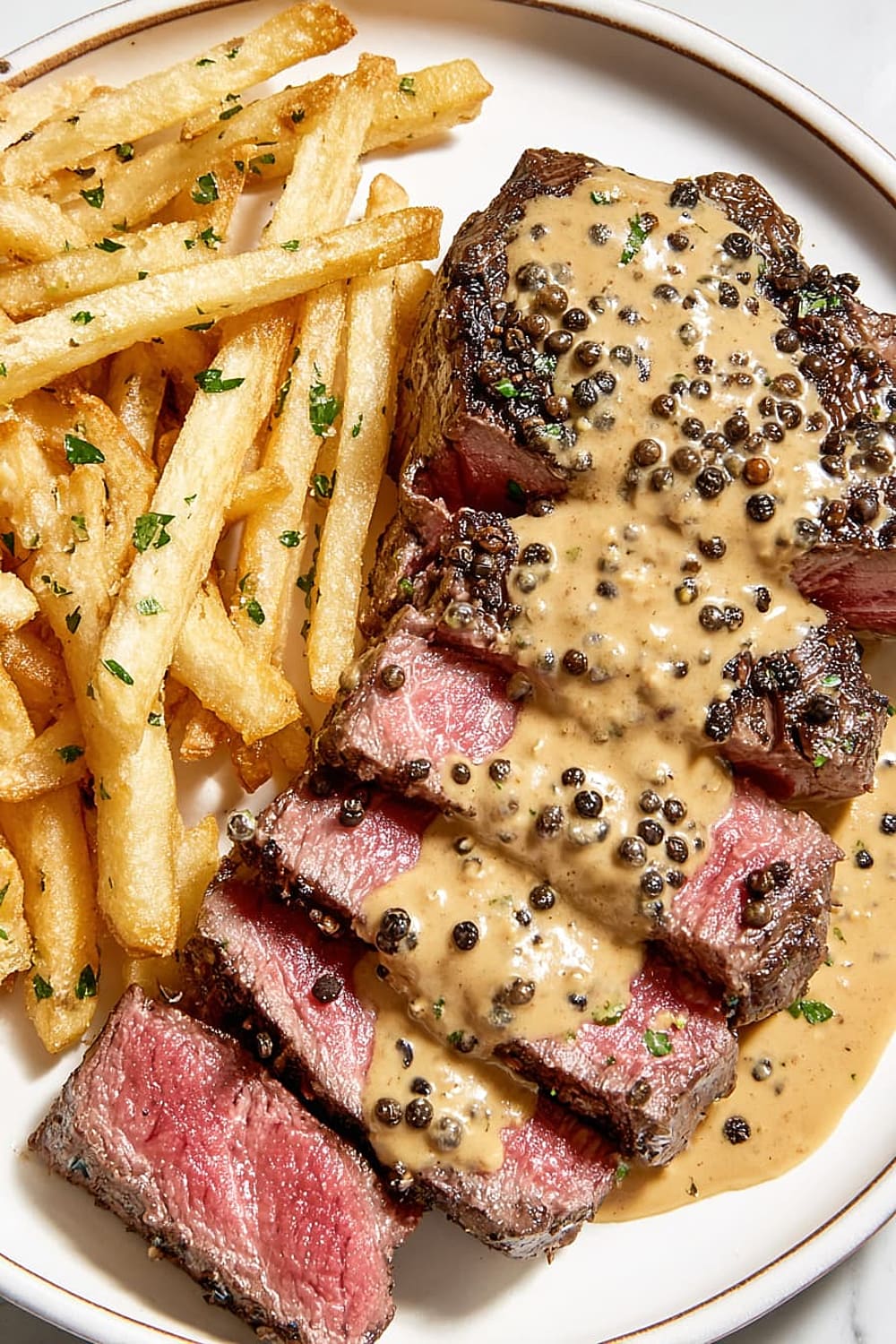
Make It Diabetes-Friendly
Carb Content Analysis:
- Current recipe: Approximately 4-5 grams of carbohydrates per serving, primarily from shallots and cream
- Main carb sources: Shallots contribute about 2 grams, while cream adds 1-2 grams per serving
- Natural fit: This recipe is already very low-carb and diabetes-friendly as written
Portion & Blood Sugar Management:
- Recommended serving: The 6-ounce steak portion provides substantial protein to help stabilize blood sugar
- Timing strategy: The high protein and fat content helps slow digestion and prevents blood sugar spikes
- Pairing suggestions: Serve with non-starchy vegetables like roasted asparagus or sautéed spinach
Optional Modifications:
- Reduce cream: Use 1/4 cup heavy cream instead of 1/2 cup to save 1-2 grams carbs per serving
- Increase vegetables: Add sliced mushrooms to the sauce for volume without significant carb increase
- Monitor sodium: Choose low-sodium beef stock if managing blood pressure alongside diabetes
Blood Sugar Impact: Minimal – the combination of protein and fat with very low carbohydrates makes this an excellent choice for stable glucose levels
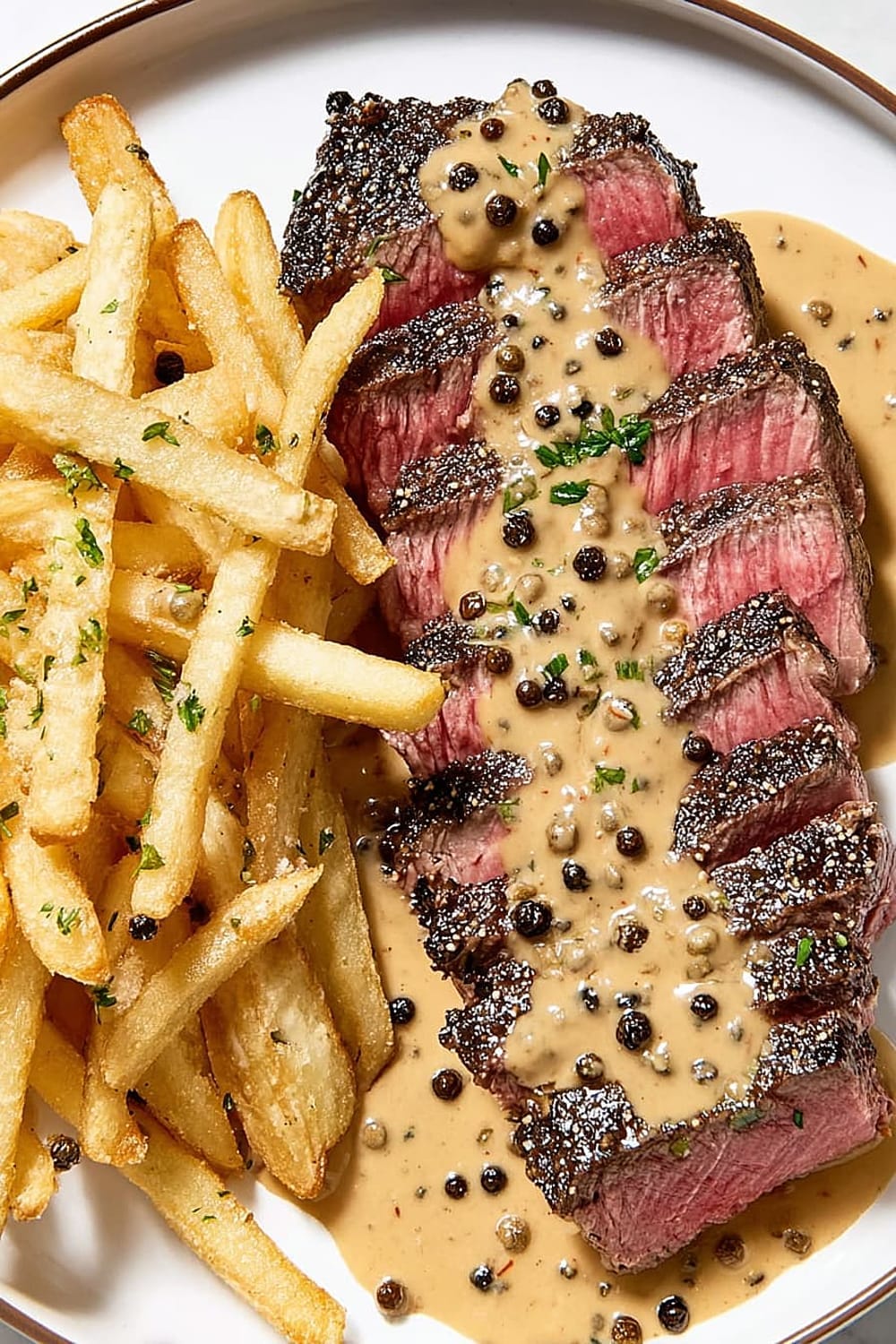
Perfect Pairing Suggestions
Wine Pairings
The rich, peppery flavors of steak au poivre pair beautifully with full-bodied red wines like Cabernet Sauvignon, Bordeaux, or Côtes du Rhône. The cognac in the sauce creates a bridge to aged spirits, so a whiskey or cognac neat makes an elegant digestif. For white wine lovers, a rich Chardonnay with oak aging complements the cream sauce without competing with the beef.
Side Dish Recommendations
Roasted fingerling potatoes with herbs provide earthy contrast to the rich sauce, while sautéed green beans or asparagus add bright color and crisp texture. Garlic mashed cauliflower offers a lower-carb alternative that soaks up the cognac sauce beautifully. A simple mixed greens salad with Dijon vinaigrette cuts through the richness and prepares the palate.
Complete Meal Ideas
Start with French onion soup or escargot to maintain the bistro theme, or keep it simple with oysters on the half shell. For dessert, crème brûlée or chocolate pot de crème continues the French influence, while fresh berries with whipped cream provides a lighter finish that won’t overwhelm after such a rich main course.
Occasion Suggestions
This dish shines for romantic dinners, anniversary celebrations, or dinner parties where you want to impress without spending all day in the kitchen. The 35-minute total time makes it perfect for weeknight entertaining or special occasion meals that feel luxurious but remain approachable.
Pro Tips and Troubleshooting
Professional Techniques
Always let steaks come to room temperature before cooking – cold meat hitting a hot pan creates uneven cooking and tough texture. When crushing peppercorns, aim for irregular pieces rather than uniform powder; this creates varying intensities of heat and flavor throughout each bite. Remove the pan from heat before adding cognac to prevent dangerous flare-ups, then return to heat for controlled reduction.
Common Mistakes and Solutions
Overcooked steak happens when the pan isn’t hot enough initially – you need that immediate sear to develop crust while keeping the interior tender. If your sauce breaks or curdles, remove from heat immediately and whisk in a tablespoon of cold cream to bring it back together. Bitter sauce usually means the shallots were overcooked or the cognac didn’t reduce properly – keep shallots translucent and simmer cognac until you can’t smell raw alcohol.
Storage and Make-Ahead
Leftover steaks can be refrigerated for 2-3 days but are best enjoyed immediately. Reheat gently in a low oven (250°F/120°C) to avoid overcooking. The sauce can be made ahead and refrigerated for up to 2 days – reheat gently and whisk in a splash of cream if it seems thick. Crushed peppercorns can be prepared up to 1 week ahead and stored in an airtight container.
Scaling and Presentation
For larger crowds, cook steaks in batches rather than overcrowding the pan, which lowers temperature and prevents proper searing. Double or triple the sauce recipe as needed. Plate on warmed dishes and spoon sauce around and over the steak for restaurant-style presentation that keeps everything at optimal serving temperature.
The beauty of steak au poivre lies in its perfect balance of technique and simplicity – you’re creating something that tastes incredibly sophisticated while using straightforward cooking methods that build confidence in the kitchen. Whether you’re celebrating a special occasion or just treating yourself to restaurant-quality food at home, this recipe delivers that perfect combination of impressive flavors and achievable techniques that make cooking feel like the rewarding, delicious adventure it should be.